Shut-off for F2D-Combat
"Four shut-off generations in one season"
Four generations of shut-off systems in one season All the secrets from my 2009 shut-off systems. |
||
|
First generation: |
||
|
The main part off the system has become well known. It was published as my 2009 system
in the early spring 2009. It is almost the same system as the shut-off systems from ViKo or Chornyy. 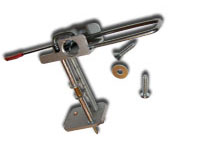
All these systems used a small swing-arm to block the system at take off. |
||
|
The idea for the mini swing-arm actual came from a model Mervyn Jones was testing at the 2008 World Cup in Barton, England. 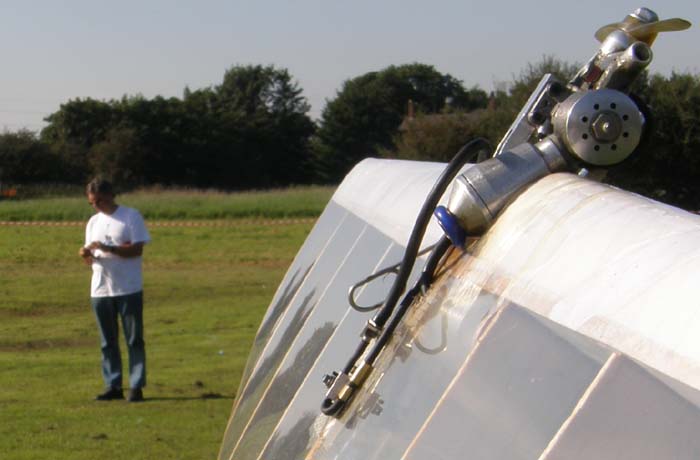
|
||
|
On Mervyn's moving bellcrank shut-off the movement of the bellcrank pin was blocked by a small lever. This lever swung away once the model was in the air. In my 2007 system both the shut-off valve function and the arming of the system were operated by the line tension. That gave a lot of problems with engines shutting down at takeoff. It was a new great idea to let the shut-off be operated by line tension and the blocking by centrifugal forces. It was my plan to use "The mini swing-arm system" for 2009 but during the manufacturing of these systems I changed the design. Actually I only built one (!) of these systems for demonstration and to prove that the concept would work. The problem with the mini swing-arm design was (and still is!) that the rules do not allow the shut-off to be blocked when the model is flying. And the mini swing-arm is blocking the shut-off for the first few metres after take-off. |
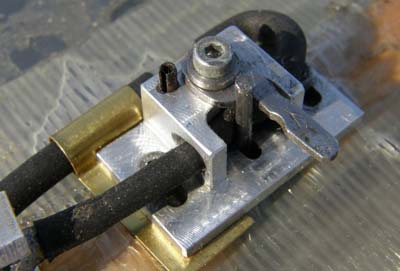 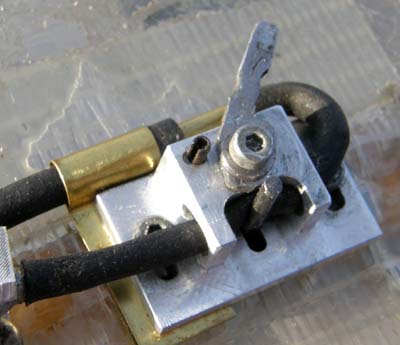
|
|
|
Second generation: |
||
To be sure not to be in conflict with the rules I designed a reservoir system that could feed the engine in the first second after takeoff.
The reservoir was made from a piece of latex tube.
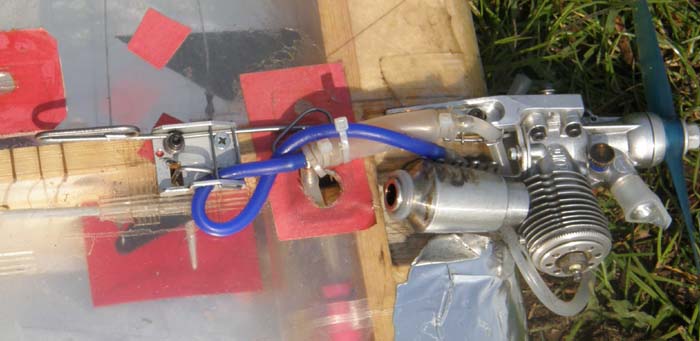 The latex in the reservoir was dimensioned so that the tank pressure would inflate the reservoir automatically. To prevent the reservoir from growing too big and to protect it in hard landings it was covered by a silicone tube. Two T-pieces were needed in the fuel line to make the bypass and the system was named the "TT-reservoir system". |
||
|
This reservoir could get the model in the air and made the shut-off system comply with the demands in the rule book - the hard core rules. A problem with this second generation was that the shut-off must be kept open (blocked) to let the mechanic start the engine. Right before takeoff the pitman had to remove this blocking and keep the shut-off open by pushing the spring on the shut-off. This was far too complicated for most mechanics to manage during a match. |
||
|
Third generation: |
||
|
To make life easier for the pitmen Bjarne Schou and I developed a new feature for shut-off systems: The mechanic valve! The idea was quite simple: Instead of forcing the shut-off open during the start period we put in an extra fuel line that would let the fuel flow directly from the tank to the engine. On this bypass there was a normally closed valve. By opening this valve the pitman could feed the engine during the starting period. |
||
|
The "mechanic valve" was made as a small lever right behind the engine. When holding a model with a running engine it would only be natural for the pitman to keep this valve open. When the pitman let off the model the valve would automatically close the bypass and the engine would be running on the fuel from the reservoir until the flying speed was high enough to open the shut-off valve. |
||
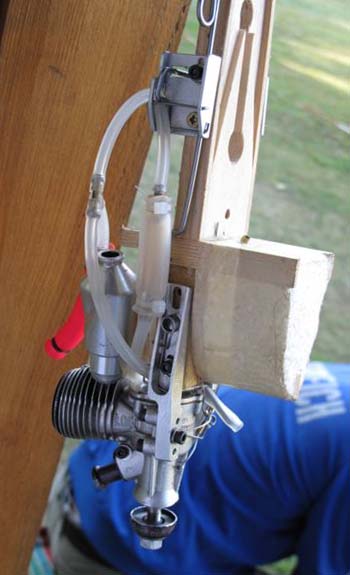 TT-reservoir and mechanic valve on display at the WorldCup in Bitterfeld, Germany |
Both Bjarne Schou and I used systems with mechanic valve and TT-reservoir in the spring 2009. A lot of people saw it in action in Bitterfeld but I don't think many realized the function of the mechanic valve. The TT-system had two big advents: It fullfills the hard core rules and it was very easy for the pitman to use it. The bad things were the complex tubing, high weight and a slow stopping of the engine. The slow stopping was solved in the next generation of the system. |
|
|
Forth generation: |
||
|
The problem with the simple latex reservoir is that the pressure is not constant. When the shut-off pinches off the fuel line the latex reservoir will feed the engine. But as soon as it starts to deliver fuel the pressure will fall. The pressure will keep falling until the reservoir is empty. Through this process the engine will get less and less fuel. It will not stop before the reservoir is empty but the engine will run on low power during this period. It would be better if the engine could run on full power as long as the reservoir is active and then stop as fast as possible. To do this the reservoir should deliver fuel at normal pressure and stop completely when it is empty. 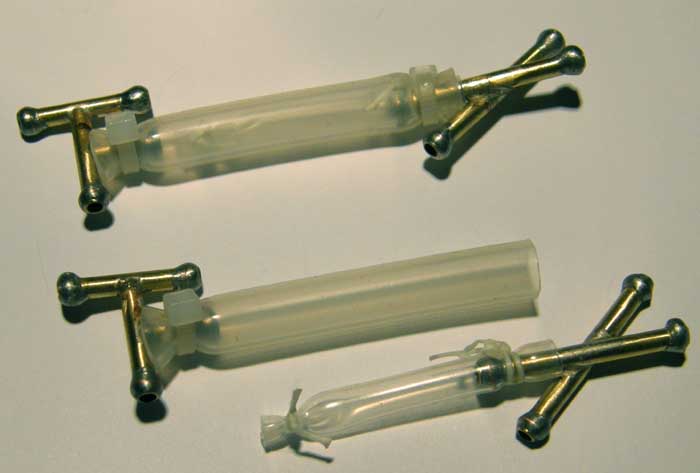
The pressure on the fuel in next generation of the reservoir came directly from the pressure in the tank. A small silicone tube was placed inside a bigger tube. The small tube was closed in one end and connected to the engine at the other end. The fuel from the tank was connected directly to the space between the two tubes. |
||
|
When the shut-off valve or the mechanic valve was open the pressure was the same inside and outside the small tube and it had its original round shape. When both valves were closed the pressure on the outside of the smaller tube pressed the fuel in the small tube into the engine. When the small silicone tube has been squeezed flat the flow will stop the same way as when the fuel line is pinched off. |
|
|
|
During this period when the small tube was delivering fuel to the engine the pressure was almost the same as the normal pressure from the tank.
This made the engine run at normal speed as long as there was fuel in the reserve and then make a quick stop when the reservoir was empty.
For the fuel line in this system I had made two special fittings. They were shaped as an F and an X so this system was named the "FX reservoir system". 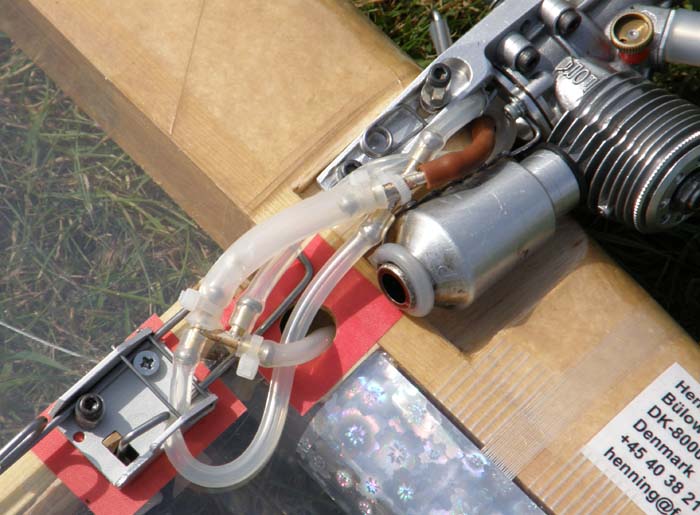 This system complies with the hard core rules, it was easy for the pitman to use and it gave the engine an on/off function with a delay. But it was heavy and resulted in a very complex system of fuel tubes on the model. I used the FX-system at the World Cup in Belgrade, European Championship and Novosmovsk (photos). 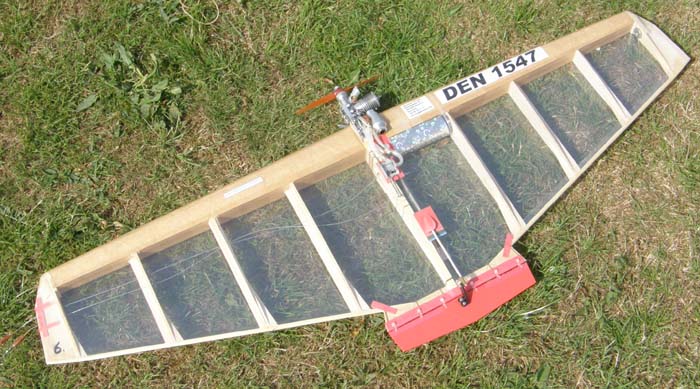
This was the long history behind the shut-off I was using in 2009. |
||
|
Next Generation: The rules for 2010 are the same as for 2009 but it will probably be allowed to use systems blocked at take-off (as it was in the 2009 season). If the proposal for new rules pass the CIAM Plenary Meeting in the spring the 2011 rules will allow shut-off systems to be blocked at takeoff as long as they become active before the combat starts. For the 2010 season I will: - go back to the mini swing arm system - or - use the FX-reservoir and the mechanic valve again - or - invent a new shut-off system! Happy new year! /Henning Forbech |
||
--= Back Start 2 3 4 5 6 7 8 9 10 11 12 13 14 15 16 17 18 19 20 21 22 23 24 25 26 27 28 29 30 31 32 33 34 35 36 37 38 39 40 41 42 43 44 45 46 47 48 49 50 Next F2D.dk =--
Shut-off start - F2D.dk